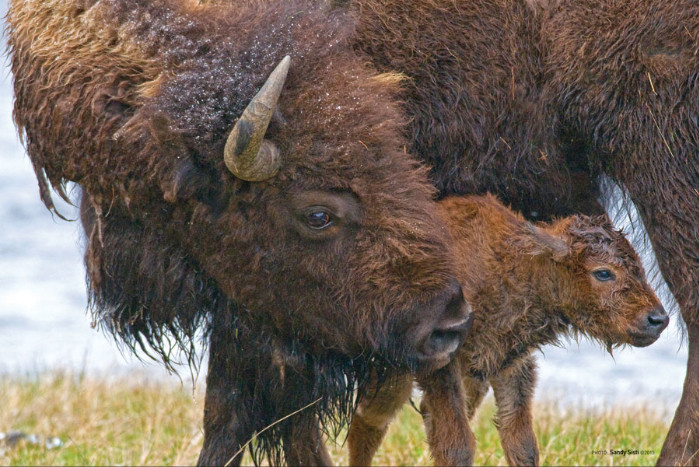
by Deep Green Resistance News Service | Mar 7, 2016 | Biodiversity & Habitat Destruction
By Buffalo Field Campaign
SPECIAL ALERT: Phone Calls Needed Today to Stop Imminent Buffalo Slaughter
Yellowstone National Park is holding approximately 150 of America’s last wild buffalo captive in their Stephens Creek bison trap. The Park Service intends to ship these gentle giants to slaughter facilities beginning this week! Why does Yellowstone slaughter America’s last wild buffalo? Because Montana’s livestock industry pressures them to. There is no justification for it, no matter what the Park Service tells you. Wild bison are not overpopulated, and the so-called brucellosis threat is a livestock industry excuse to kill wild buffalo and prevent them from reinhabiting their native landscape.
So many of you have been taking action, calling Yellowstone National Park, and urging them to set these buffalo free. Thank you so much! Unfortunately, Yellowstone has been unresponsive. Yellowstone’s superintendent still needs to hear from you, but we need to increase our pressure and take our message all the way up to the White House. We also need to contact Montana Governor Steve Bullock and tell him to end livestock industry authority over wild, migratory bison, which is the driving force behind Yellowstone’s participation in the slaughter of America’s last wild buffalo.
PLEASE TAKE ACTION TODAY!
* CALL PRESIDENT OBAMA AT THE WHITE HOUSE: #202-456-1111
Tell President Obama to make Yellowstone stop the buffalo slaughter and set the captive buffalo free! There is no justification for killing members of the world’s most important bison population, beloved the world over. Tell the President you do not want your hard-earned tax dollars to be spent on destroying a natural, national treasure.
* CALL MONTANA GOVERNOR STEVE BULLOCK: #406-444-3111
Tell him you stand with the majority of Montanans who want wild, migratory bison restored in this state. Tell him bison slaughter hurts tourism, and insist that he work to end livestock industry policies and intolerance, which are the driving force behind Yellowstone’s participation in the slaughter of America’s last wild buffalo.
* CALL YELLOWSTONE’S SUPERINTENDENT DAN WENK: #307-344-2002
Demand that he cease catering to livestock industry intolerance, release the captured buffalo, and end plans to slaughter! His willing participation in slaughtering America’s last wild buffalo goes against the National Park Service’s mission and Yellowstone’s own bison science!
Thank you so much for taking these actions for the country’s last wild buffalo!
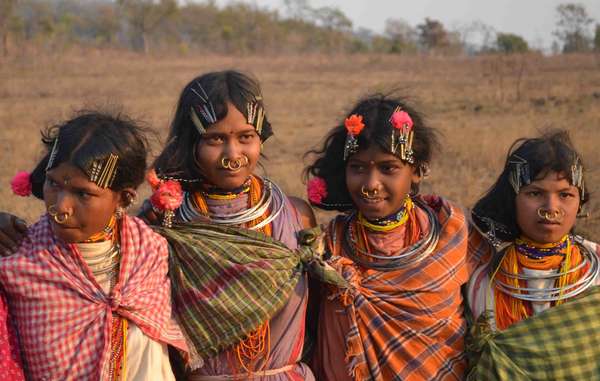
by Deep Green Resistance News Service | Mar 1, 2016 | Indigenous Autonomy, Mining & Drilling
Featured image: The Dongria unanimously rejected the mining project and have vowed to protect the Niyamgiri hills © Bikash Khemka/Survival International
By Survival International
A tribe in eastern India are facing a new threat from mining on their ancestral land, despite having won a major “David & Goliath” legal battle in 2014.
The Dongria Kondh were originally threatened by international mining corporation Vedanta Resources, who tried to open a bauxite mine in their sacred Niyamgiri hills, but were prevented by the Indian Supreme Court, which ruled that the Dongria should decide whether to allow the mine to go ahead.
The tribe unanimously rejected Vedanta’s plans to mine their hills during a historic referendum in which all twelve villages that were consulted voted against the mine.
Now, however, the Odisha state is trying to re-open the issue, petitioning for the right to hold another referendum for the Dongria to pave the way for a large-scale mining operation, this time by state-run Odisha Mining Corporation.
British-owned Vedanta opened a bauxite refinery close to the Dongria’s hills without having secured permission to mine in the area. Even though the mine itself was quashed, the refinery has continued to operate at a loss.
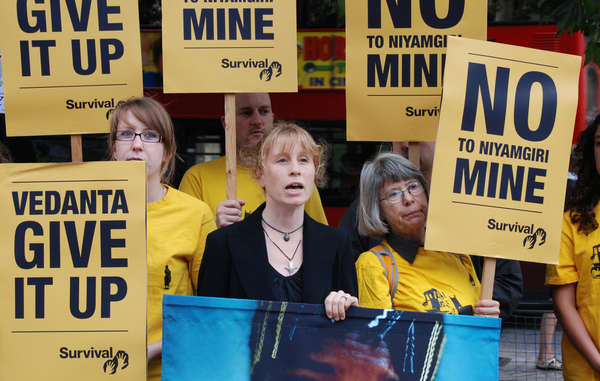
Survival campaigned against Vedanta’s plans and will continue to advocate for the Dongria’s right to protect their sacred hills.
© M. Cowan/Survival International
Despite strong resistance to the project from the Dongria, who have lived in the Niyamgiri hills for generations, the state authorities are keen to keep the refinery open and expand mining operations in the region.
Last year Mukuna Sikaka, a Dongria tribesperson, said: “We are not going to allow mining over Niyamgiri at any cost – not for all the developmental efforts of the government.”
Survival International led a successful global campaign against Vedanta’s plans, and is now calling for the Odisha state authorities to respect the Dongria’s decision to reject the mine.
Survival Director Stephen Corry said: “It is bitterly disappointing to see that the Odisha state authorities have still not learned to respect the wishes of the Dongria Kondh. Tribal peoples have a right under Indian and international law to determine what happens on their lands, yet still governments and corporations insist on putting profits before people’s wishes. Attempts to resume this project after international outcry and stern resistance from the Dongria themselves are not only un-democratic and illegal, but also deeply immoral.”
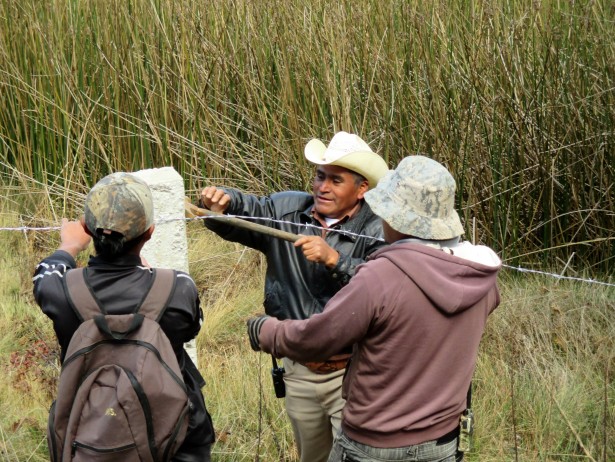
by Deep Green Resistance News Service | Feb 28, 2016 | Biodiversity & Habitat Destruction, Indirect Action
Featured image: Candelaria residents erect a fence around the Suyul Lagoon to help protect it from intruders. (Waging Nonviolence/Sandra Cuffe)
By Sandra Cuffe / Waging Nonviolence
The reeds and grasses are as tall as Sebastián Pérez Méndez, if not taller. The vegetation is so thick it’s hard to see the water in the Suyul Lagoon that he and other local Maya Tzotzil residents are working hard to protect. Pérez Méndez crosses the road to point out where aquatic plants serve as a natural filter for the water as it flows out the lagoon, located in the highlands of Chiapas, in southern Mexico.
“The water is under threat,” he said. Pérez Méndez is the top authority of the Candelaria ejido, a tract of communally-held land in the municipality of San Cristóbal de las Casas. “We’re not going to allow it.”
Communities in Chiapas are organizing to protect the Suyul Lagoon and communal lands from a planned multi-lane highway between the city of San Cristóbal de las Casas and Palenque, where Mayan ruins are a popular tourist destination. Candelaria residents continue to take action locally to protect the lagoon. They also traveled from community to community along the proposed highway route, forming a united movement opposing the project.
It all started back in 2014 when government officials showed up in Candelaria looking for ejido authorities, including Pérez Méndez’ predecessor. It was the first residents had heard about plans for the highway. The indigenous inhabitants had not been consulted and were not shown detailed plans.
“They realized that [the government officials] were only seeking signatures,” Pérez Méndez said.
No one person or group is authorized to make a decision that would affect ejido lands, however, and there are strict conditions in place to ensure elected ejido leaders are accountable to members, he explained. An extraordinary assembly was held to discuss the highway project.
The Candelaria ejido was established in 1935, a year after a new agrarian law enacted during the Lázaro Cárdenas administration led to widespread land reform throughout Mexico. More than 2,000 people live in the 1,600-hectare ejido, and more than 800 of them are ejidatarios — legally recognized communal land holders whose rights have been passed down for generations. Only ejidatarios as a whole have the power to make decisions on issues like the highway project.
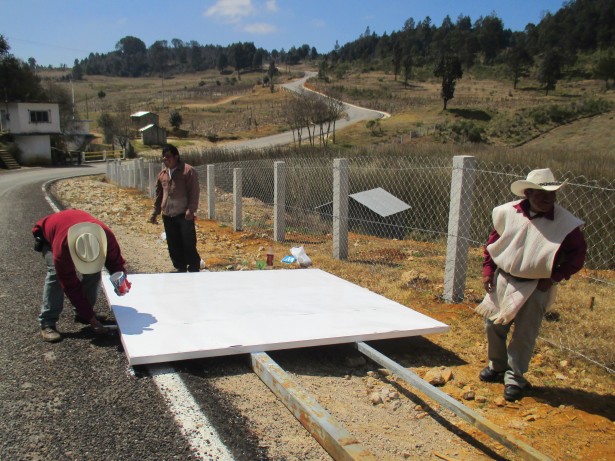
Candelaria residents paint over graffiti to fix up a roadside sign proclaiming their opposition to the highway project. (Waging Nonviolence/Sandra Cuffe)
“The ejido said no,” said Guadalupe Moshan, who works for the Fray Bartolomé de Las Casas Human Rights Center, or FrayBa, supporting Candelaria and other communities in Chiapas. “They didn’t sign.”
Candelaria leaders sought assistance from FrayBa in 2014, after they were approached by government officials and pressured to sign a document indicating their consent to the highway project that would involve a 60-meter-wide easement through communally-held lands. Officials told community members that the highway was already approved and that they would be well compensated, but that there would consequences if they refused to sign, Moshan said.
“They told them they would suspend government programs and services,” she explained. In the days following the extraordinary ejido assembly rejecting the project, there was unusual activity in the area, according to Moshan. Helicopters flew over theejido, unknown individuals entered at night, and trees were marked, she said.
Protecting the Suyul Lagoon remains at the heart of Candelaria’s opposition to the planned highway. The lagoon provides potable water not only for Candelaria, but also for several nearby communities, said ejido council secretary Juan Octavio Gómez. Aside from the highway itself, project plans eventually shown to the community leaders include a proposed eco-tourism complex right next to the lagoon. That isn’t in the communities’ interest, Gómez explained.
“Water is life. We can’t live without it,” he said. “Without this lagoon, we don’t have another option for water.”
Fed by a natural spring, the Suyul Lagoon never runs dry. Local residents are careful to protect the water and lands in the ejido, where the majority of residents live from subsistence agriculture, sheep rearing and carpentry. They engage in community reforestation, but have plans to plant more trees, Gómez said.
The Suyul Lagoon is also sacred to local Maya Tzotzil. Ceremonies held every three years in its honor involve rituals, offerings, music and dance.
“It is said that it’s the navel of Mother Earth,” Pérez Méndez said.
Candelaria residents didn’t sit back and relax after rejecting the highway project in their extraordinary assembly. They have been organizing ever since. The Suyul Lagoon lies just outside the Candelaria ejido, but it belongs to ejidatarios by way of an agreement with the supportive land owner. Aside from the highway project and potential eco-tourism complex, the lagoon has caught the attention of companies, whose representatives have turned up in the area expressing interest in establishing a bottling plant.
It’s cold in February up in the highlands, but community members have been out all day, erecting a fence around the Suyul Lagoon to protect it from intruders. White fence posts are visible under the treeline across the sea of reeds. Like so many other local initiatives, fence materials are collectively financed by the ejido and the labor is all voluntary, communal work.
While residents continue stringing barbed wire from post to post, others take paintbrushes to one of their roadside signs. Locals have erected large signs next to roads in and around their ejido, announcing their opposition to the tourist highway.
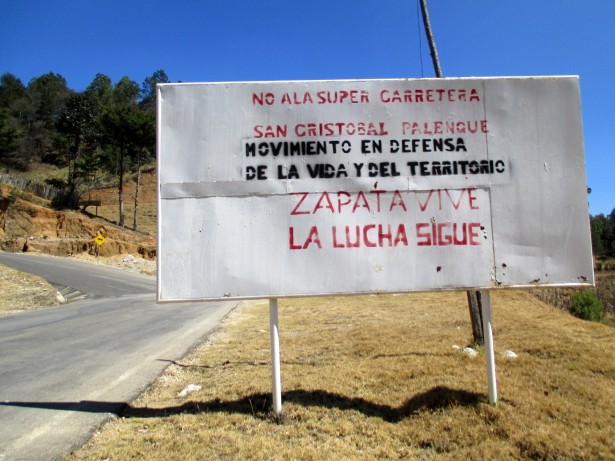
A sign along the road leading to Candelaria informs passers-by of opposition to the planned super-highway. (Waging Nonviolence/Sandra Cuffe)
“We’re also already organized with the other communities,” Pérez Méndez said. “All the communities reject the super-highway.”
After they were approached by government officials, Candelaria ejido residents traveled from community to community along the entire planned highway route. Some communities hadn’t heard of the project at all, while others said they were pressured into signing documents indicating their consent, Pérez Méndez said. As a result of Candelaria’s visits, community organizing along the highway route led to the formation of a united front of opposition, the Movement in Defense of Life and Territory.
Candelaria also recently got together with other indigenous communities in the highlands to issue a joint statement rejecting the tourist super-highway and a host of other government and corporate projects and policies.
“Our ancestors, our grandfathers and our grandmothers have always taken care of these blessed lands, and now it’s our turn to [not only take] care of the lands, but also to defend them,” reads the February 10 communiqué.
“The neoliberal capitalist system, in its ambition to exploit natural assets, invades our lands,” the statement continues. “The government and transnational companies are violently imposing their mega-projects.”
Back along the edge of the Suyul Lagoon, Candelaria residents continue to string barbed wire from post to post. They’ve been at it for a while now, according to Pérez Méndez, but they’ve now stepped up their efforts and hope to finish the fence by the end of the month.
Pérez Méndez surveys the progress, protected from the unrelenting sun and icy wind by his hat and white sheep’s wool tunic. He becomes pensive when asked if he thinks communities will be able to defeat the highway project.
“Yes,” the ejido leader said, after giving it some thought. “We can stop it.”

by Deep Green Resistance News Service | Feb 18, 2016 | Biodiversity & Habitat Destruction
By Deep Green Resistance
Wild Bison are an icon of what has been destroyed by civilization, and this species is now on the brink in the wild. Almost all bison left today are cross-breeds held in confinement. There are only a few wild, free ranging bison herds left on the planet, and their numbers are small. Every year, the Park Service — at the behest of ranchers — round up, quarantine, harass, and kill many of the wild bison who live in and around Yellowstone National Park. We stand with grassroots land defenders such as the Buffalo Field Campaign in calling for an immediate end to this atrocious treatment of wild bison. Instead of quarantine, these creatures need room to roam. Instead of harassment, they need our assistance in growing once again to their historical numbers.
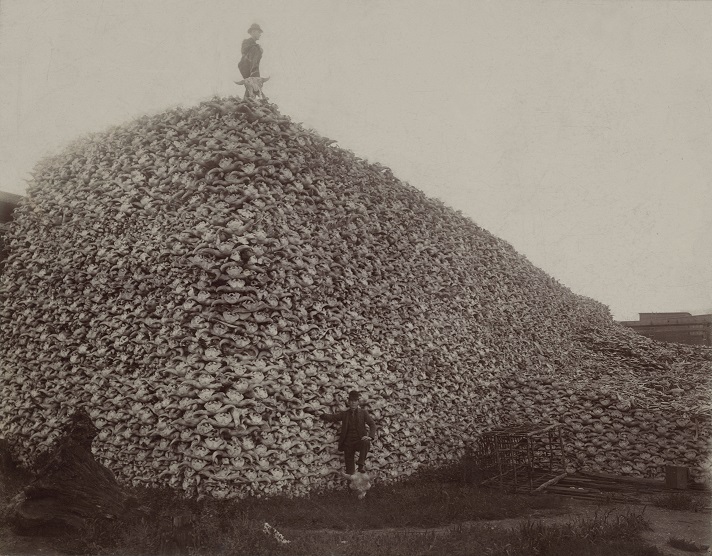
From Buffalo Field Campaign:
Yellowstone National Park has released an Environmental Assessment (EA) for a fifty-year quarantine program which seriously threatens America’s last wild, migratory bison population. Unfortunately there is very little in this EA for bison advocates to support, as even the “no action” alternative maintains the Park’s ongoing capture-for-slaughter program. Comments are due by midnight MDT February 29, 2016. (This is a new, extended deadline.)
Quarantine domesticates wild bison, subjects them to artificial selection and commercial management practices and treats them like livestock. Quarantine is an insult to First Nations buffalo cultures with strong cultural, spiritual, and traditional ties to wild, migratory buffalo in and around Yellowstone. Quarantining wild, migratory bison and dooming them to a life behind fences ignores the critical keystone relationship between wild bison and their natural prairie and grassland communities. Migration is one of the buffalo’s strongest, most significant gifts to a healthy landscape. Quarantine reduces buffalo to a domesticated state, and is not appropriate for wildlife. Quarantine, which imposes a state of control and surveillance over wild bison, is the direct result of the livestock industry’s intolerance. Quarantine is a toxic mimic of natural restoration, a program in which humans manipulate the wild and free to suit their own selfish agendas. Quarantine does not end slaughter, it begins with it, ripping buffalo families apart and orphaning calves who spend the rest of their lives behind fences.
Yellowstone’s ongoing capture-for-slaughter and fifty-year quarantine plan will result in extremely adverse cumulative impacts, and we need to force the agency to seriously and honestly review the best available scientific information in a comprehensive Environmental Impact Statement (EIS).
Recent history has already shown that quarantine does not work for wild bison. The Quarantine Feasibility Study that began in 2005 resulted in wild Yellowstone buffalo being commercially owned for profit, while some of the buffalo who went to Ft. Peck died in a horrible fire because they could not escape their enclosure, and half of the herd that was transferred to Ft. Belknap died because they could not escape their enclosure to find fresh water. Wild bison do not belong behind fences, they are a nation unto themselves who evolved to migrate, wild and free!
TAKE ACTION! Please use the sample letter below only as an example, and in your own words, address the adverse impacts of quarantining wild bison and the Park’s ongoing capture for slaughter mismanagement scheme. Don’t allow Yellowstone National Park to domesticate wild, migratory bison!
HOW TO SEND YOUR COMMENTS: Respondents are encouraged to submit their comments online through the Planning, Environment and Public Comment (PEPC) website at www.parkplanning.nps.gov/BisonQuarantine. Comments may also be hand-delivered to the park administration building, or mailed to: Superintendent, Yellowstone National Park, Wyoming, 82190. Comments will NOT be accepted by fax, e-mail, or in any manner other than those specified above.
SAMPLE LETTER – Please edit with your own remarks! See above for instructions on how to submit your comments. Due by February 29, 2016.
Superintendent Dan Wenk
Yellowstone National Park
Attn: Bison Quarantine EA
P.O. Box 168
Yellowstone National Park, Wyoming 82190
RE: Comments on Yellowstone Bison Quarantine Program EA
Dear Superintendent Wenk,
Thank you for the opportunity to comment on Yellowstone’s quarantine environmental assessment (EA). I am strongly opposed to Yellowstone’s proposed fifty-year quarantine plan as well as the Park’s ongoing capture-for slaughter operations. As an advocate for wild, migratory bison, I find it impossible to support quarantine in Yellowstone or elsewhere, or your no-action alternative to continue capturing wild buffalo for slaughter.
Yellowstone’s proposed fifty-year quarantine plan, as well as the Park’s ongoing capture-for-slaughter operations have significant cumulative negative impacts, which requires your agency to seriously and thoroughly review the best available information in a comprehensive Environmental Impact Statement.
The U.S. Congress never intended for wild buffalo in Yellowstone to be declared “surplus” and did not authorize the Secretary of the Interior to remove wild buffalo as “surplus” for quarantine. By regulation, Yellowstone National Park is prohibited from removing “surplus” wild buffalo from the population in Yellowstone “when the animals are to be slaughtered, or are to be released without adequate protection from premature hunting.” 36 C.F.R. § 10.3(d) (2015).
Yellowstone’s fifty-year quarantine program is in direct violation of the Organic Act and National Park Service policies, as it includes capturing wild bison for quarantine with potential recipients including agricultural or commercial producers, reducing ecologically extinct wild bison to livestock.
Wild bison are further adversely impacted by Yellowstone’s proposed quarantine plan and ongoing capture-for-slaughter operations, which aim to reduce America’s last continuously wild herds to a mere 3,000 animals, and maintain this low population, making wild bison extremely vulnerable by threatening their natural immunity to introduced diseases from cattle and elsewhere, including brucellosis. Such poor management practices increase the risk of wild bison becoming more vulnerable to various diseases as strains become more virulent and persistent. Further, the population target of 3,000 is based on livestock industry politics and lacks scientific or ecological basis.
In recent history, Yellowstone’s participation in the state-federal Quarantine Feasibility Study resulted in the commercialization and privatization of wild bison, making a commodity of our nation’s valued wildlife. It resulted in the domestication of wild bison originating from Yellowstone. All of the wild bison who survived the quarantine feasibility study have been reduced to private livestock or meat behind fences, many of which died throughout the process, through transport to other quarantine facilities, or who suffered horrible deaths by fire and dehydration as a result of their confinement.
The recent quarantine program has been a failure. There is no indication that quarantine with the costly, restrictive, and burdensome requirements of the U.S. Department of Agriculture will in any way lead to the recovery of ecologically extinct wild bison as a wildlife species anywhere in the country. Quarantine domesticates. It harms and degrades the wild integrity of America’s last wild bison population and subjects wild bison to commercial management practices and artificial selection.
Indigenous people of North America have held strong cultural and spiritual ties to wild, migratory buffalo for tens of millennia. Some of these relationships are so deep that the people consider the buffalo to be actual relatives. “Offering” indigenous buffalo cultures the return of their relatives through quarantine and capture-for-slaughter can be viewed as a continuation of the U.S. government’s assimilation program, which aims to make cattle out of wild, migratory bison, and livestock producers out of traditionally nomadic indigenous buffalo cultures.
Ongoing capture-for-slaughter operations and the proposed quarantine program are a violation of the treaty rights held by more than twenty-five sovereign, indigenous nations. The harmful programs of hazing, quarantine, and slaughter prevent wild, migratory bison from restoring themselves on their native landscape, including open and unclaimed public lands. These nation-to-nation treaties, which the federal government has a legal obligation to honor, hold that these indigenous cultures have a sovereign right to hunt, gather, and hold ceremony on open and unclaimed lands. Sadly, wild, migratory bison are absent and unavailable on many of these lands due to these bison management practices.
Yellowstone’s fifty-year quarantine plan further harms wild, migratory bison because quarantine has adverse impacts on herd dynamics, social structure, and collective wisdom handed down through generations. Quarantine negatively modifies wild bison behavior in ways that are unnatural and harmful, including continuing pressures of domestication, conditioning to human manipulation, and artificial selection — all tools for managing livestock, not wildlife. Wild, migratory bison are able to take care of themselves, with no cost or need of interference from humans. Wild bison are able to create and manage their own habitat, while bison behind fences invoke restrictive, costly, and burdensome requirements by the U.S. Department of Agriculture.
Yellowstone National Park’s voluntary agreement to adhere to the highly controversial Interagency Bison Management Plan contradicts the mission of the National Park Service. The Park Service and other IBMP member agencies fail to operate using the best available science and information, falling back instead on expired information and misguided assumptions, in direct violation of the Park Service’s mandate.
Nearly 6,000 ecologically extinct, wild, migratory bison have been killed or eliminated from America’s last continuously wild population with direct and indirect participation from Yellowstone National Park, through capture-for-slaughter, quarantine, hazing fatalities, and the surrender of wild bison for scientific experiment. An independent population viability analysis must be conducted (and funded) by Yellowstone National Park to determine how management actions and consequent cumulative impacts threaten the long-term viability, diversity, integrity, and evolutionary potential of wild, migratory bison. It is also required that an impairment review be undertaken to determine the long-term and cumulative impacts of capture-for-slaughter operations and the proposed fifty-year quarantine program.
There is a win-win situation for wild, migratory bison and indigenous buffalo cultures that does not include the mass killing or domestication of wild bison: natural restoration through the simple and ancient natural phenomenon of migration. Migration corridors must be protected and made available to wild bison by federal, state, and public trust land management agencies, working with private landowners and tribal governments. The migration corridors in and around Yellowstone are a first priority, along with the protection of the bison themselves — both of which are denied under current management. When wild bison are protected and allowed to restore themselves throughout their native range, they will naturally return to the lands that are their birthright, lands they have been forcibly and lethally removed from, where indigenous buffalo cultures are ready to welcome them home.
Sincerely,
[Your name]
Read more at Buffalo Field Campaign. Help support BFC here.
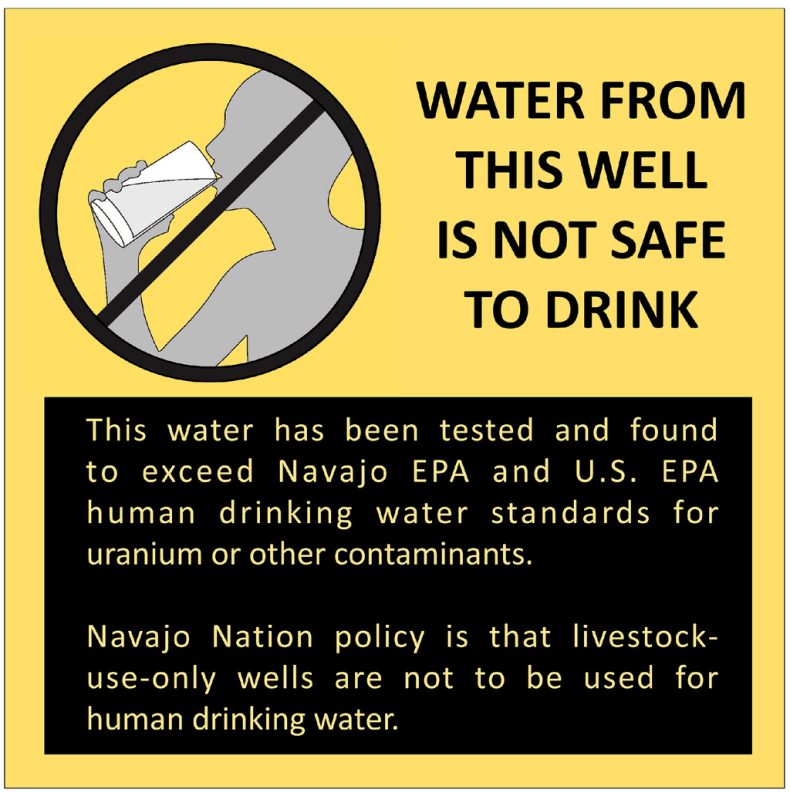
by Deep Green Resistance News Service | Feb 11, 2016 | Colonialism & Conquest, Toxification
Featured image: Figure from EPA Pacific Southwest Region 9 Addressing Uranium Contamination on the Navajo Nation
By Courtney Parker / Intercontinental Cry
Recent media coverage and spiraling public outrage over the water crisis in Flint, Michigan has completely eclipsed the ongoing environmental justice struggles of the Navajo. Even worse, the media continues to frame the situation in Flint as some sort of isolated incident. It is not. Rather, it is symptomatic of a much wider and deeper problem of environmental racism in the United States.
The history of uranium mining on Navajo (Diné) land is forever intertwined with the history of the military industrial complex. In 2002, the American Journal of Public Health ran an article entitled, “The History of Uranium Mining and the Navajo People.” Head investigators for the piece, Brugge and Gobel, framed the issue as a “tradeoff between national security and the environmental health of workers and communities.” The national history of mining for uranium ore originated in the late 1940’s when the United States decided that it was time to cut away its dependence on imported uranium. Over the next 40 years, some 4 million tons of uranium ore would be extracted from the Navajo’s territory, most of it fueling the Cold War nuclear arms race.
Situated by colonialist policies on the very margins of U.S. society, the Navajo didn’t have much choice but to seek work in the mines that started to appear following the discovery of uranium deposits on their territory. Over the years, more than 1300 uranium mines were established. When the Cold War came to an end, the mines were abandoned; but the Navajo’s struggle had just begun.
Back then, few Navajo spoke enough English to be informed about the inherent dangers of uranium exposure. The book Memories Come to Us in the Rain and the Wind: Oral Histories and Photographs of Navajo Uranium Miners and Their Families explains how the Navajo had no word for “radiation” and were cut off from more general public knowledge through language and educational barriers, and geography.
The Navajo began receiving federal health care during their confinement at Bosque Redondo in 1863. The Treaty of 1868 between the Navajos and the U.S. government was made in the good faith that the government – more specifically, the Bureau of Indian Affairs (BIA) – would take some responsibility in protecting the health of the Navajo nation. Instead, as noted in “White Man’s Medicine: The Navajo and Government Doctors, 1863-1955,” those pioneering the spirit of western medicine spent more time displacing traditional Navajo healers and knowledge banks, and much less time protecting Navajo public health. This obtuse, and ultimately short-sighted, attitude of disrespect towards Navajo healers began to shift in the late 1930’s; yet significant damage had already been done.
Founding director of the environmental cancer section of the National Cancer Institute (NCI), Wilhelm C. Hueper, published a report in 1942 that tied radon gas exposure to higher incidence rates of lung cancer. He was careful to eliminate other occupational variables (like exposure to other toxins on the job) and potentially confounding, non-occupational variables (like smoking). After the Atomic Energy Commission (AEC) was made aware of his findings, Hueper was prohibited from speaking in public about his research; and he was reportedly even barred from traveling west of the Mississippi – lest he leak any information to at-risk populations like the Navajo.
In 1950, the U.S. Public Health Service (USPHS) began to study the relationship between the toxins from uranium mining and lung cancer; however, they failed to properly disseminate their findings to the Navajo population. They also failed to properly acquire informed consent from the Navajos involved in the studies, which would have required informing them of previously identified and/or suspected health risks associated with working in or living near the mines. In 1955, the federal responsibility and role in Navajo healthcare was transferred from the BIA to the USPHS.
In the 1960’s, as the incidence rates of lung cancer began to climb, Navajos began to organize. A group of Navajo widows gathered together to discuss the deaths of their miner husbands; this grew into a movement steeped in science and politics that eventually brought about the Radiation Exposure Compensation Act (RECA) in 1999.
Cut to the present day. According to the US EPA, more than 500 of the existing 1300 abandoned uranium mines (AUM) on Navajo lands exhibit elevated levels of radiation.
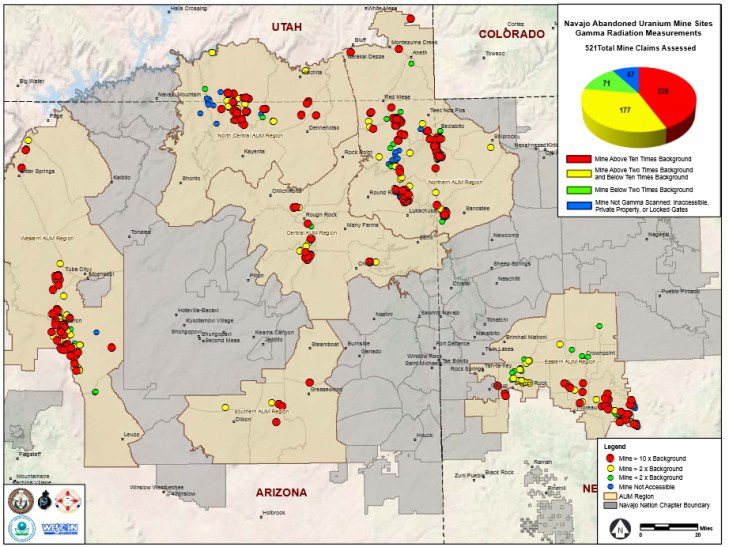
Navajo abandoned uranium mines gamma radiation measurements and priority mines. US EPA
The Los Angeles Times gave us a sense of the risk in 1986. Thomas Payne, an environmental health officer from Indian Health Services, accompanied by a National Park Service ranger, took water samples from 48 sites in Navajo territory. The group of samples showed uranium levels in wells as high as 139 picocuries per liter. Levels In abandoned pits were far more dangerous, sometimes exceeding 4,000 picocuries. The EPA limit for safe drinking water is 20 picocuries per liter.
This unresolved plague of radiation is compounded by pollution from coal mines and a coal-fired power plant that manifests at an even more systemic level; the entire Navajo water supply is currently tainted with industry toxins.
Recent media coverage and spiraling public outrage over the water crisis in Flint, Michigan has completely eclipsed the ongoing environmental justice struggles of the Navajo. Even worse, the media continues to frame the situation in Flint as some sort of isolated incident.
Madeline Stano, attorney for the Center on Race, Poverty & the Environment, assessed the situation for the San Diego Free Press, commenting, “Unfortunately, Flint’s water scandal is a symptom of a much larger disease. It’s far from an isolated incidence, in the history of Michigan itself and in the country writ large.”
Other instances of criminally negligent environmental pollution in the United States include the 50-year legacy of PCB contamination at the Mohawk community of Akwesasne, and the Hanford Nuclear Reservation (HNR) situated in the Yakama Nation’s “front yard.”
While many environmental movements are fighting to establish proper regulation of pollutants at state, federal, and even international levels, these four cases are representative of a pervasive, environmental racism that stacks up against communities like the Navajo and prevents them from receiving equal protection under existing regulations and policies.
Despite the common thread among these cases, the wave of righteous indignation over the ongoing tragedy in Flint has yet to reach the Navajo Nation, the Mohawk community of Akwesasne, the Yakama Nation – or the many other Indigenous communities across the United States that continue to endure various toxic legacies in relative silence.
Current public outcry may be a harbinger, however, of an environmental justice movement ready to galvanize itself towards a higher calling, one that includes all peoples across the United States, and truly shares the ongoing, collective environmental victories with all communities of color.
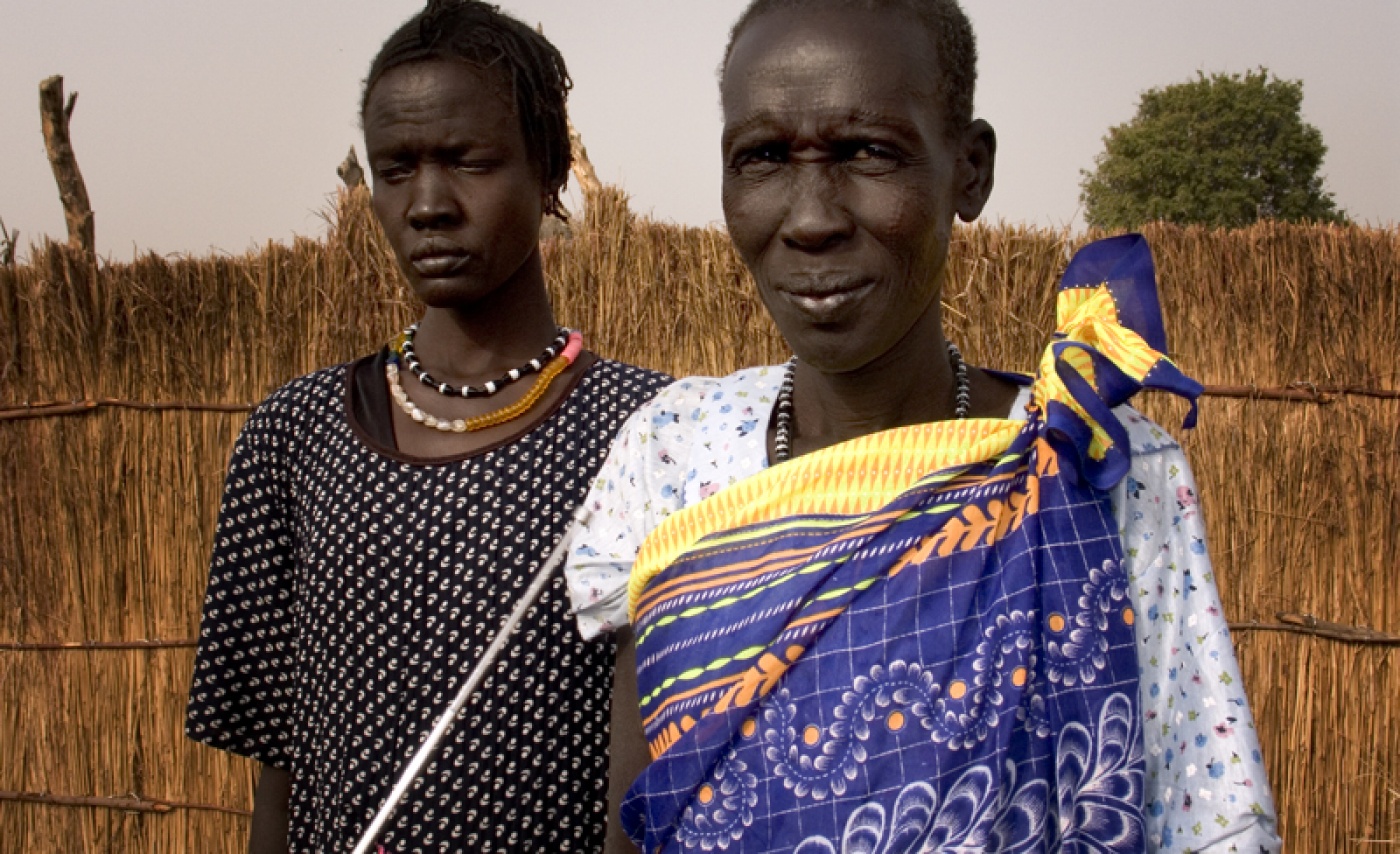
by Deep Green Resistance News Service | Feb 1, 2016 | Agriculture, Colonialism & Conquest
Featured image: Two Anuak women in the Gambella Province of Ethiopia. By Julio Garcia on March 18, 2007.
By Cultural Survival
On December 28, 2015 Ethiopia’s Agricultural Ministry revoked their contract with Karuturi Global Limited, an Indian company who in 2010 won a concession for 100,000 hectares of land to be developed for industrial agriculture for export in the Gambella region of southern Ethiopia, home to the Indigenous Anuak, Mezenger, Nuer, Opo, and Komo peoples. The Agricultural Ministry’s land investment agency cancelled the concession on the grounds that by 2012 Karuturi had developed only 1,200 hectares of land within the initial two year period of the contract.
Since 2013 the company began spiraling out of control, when it was found guilty of tax evasion in in a similar land grab venture in Kenya, and the following year had its operations was taken over by Stanbic Bank.
Karaturi’s Managing Director Sai Ramakrishna has challenged the Agricultural Ministry’s project termination in Ethiopia, telling Bloomberg Business, “I don’t recognize this cancellation,” and is seeking arbitration. If international arbitration is granted, Karuturi will advocate for the continuation of the company’s commercial agriculture plan. Ethiopian officials have dismissed their claims.
Karuturi Global’s project failure resembles that of many foreign investors who have purchased land under the Ethiopian government’s push to lease Indigenous lands to foreign investors, in what many term “land grabbing.” According to Bloomberg, none of these farms in Ethiopia have reported any success in exporting crops.
Ethiopia’s land leasing plans were described as a roadmap to development. Called “villagisation,” the plan involved removing the Indigenous Peoples who sustain themselves from their lands practising farming, hunting, gathering, and pastoralism, and grouping them into established villages, with the idea that the land would be used to produce large scale industrial agriculture to sustain the population’s food needs. Jobs would be created, turning Indigenous Peoples into wage workers who could then buy foods. But Karaturi’s plans were different–aiming to export grains for sale abroad rather than selling them locally, despite Ethiopia’s ban on the export of cereal crops.
The socio-economic transformation promised by the regional government was never realized. Rather, villagisation has meant the forced removal of Indigenous Peoples from their ancestral lands and the creation of an aid-dependant food source. Obang Metho, Anuak human rights activist from Gambella, explained in a video with local media Ethiopian Satellite Television, “This was not empty land. People have been living on this land for generations. When I grew up we didn’t have an office job to earn wages, people depend on land. Our supermarket is going to the field. The field was our bank. When you take away our lands, you are taking away our livelihood, our futures.”

An aerial view of the Dadaab Refugee Camp in Kenya where many Anuak people turned to for shelter after forced removal from Gambella. Photograph taken on November 1, 2011 by Oxfam International
On a morning in late 2010 the Anuak peoples living in the province of Gambella were met by regional government officials and soldiers. Without their knowledge or consent the Ethiopian government had sold an estimated 42% of Anuak land to foreign investors. The Anuak people were forced to leave their only known livelihoods, including essential food sources, and move to government sponsored “villages” which soon turned into refugee camps. In 2012, Human Rights Watch published its report, “’Waiting Here for Death’ Forced Displacement and “Villagization” in Ethiopia’s Gambella Region” documenting the “forcible moving tens of thousands of indigenous people in the western Gambella region from their homes to new villages under a ‘villagization’ program.”
“In their old village there was a school under a mango tree. In the new village, donor money had paid for a new school building. The children, however, were too hungry to attend, roaming instead in the forest looking for food… but now the government can show the world there is a ‘school’” –Anuak refugee displaced to the Dadaab Refugee Camp in Kenya (from The Guardian’s article, Ethiopia’s rights abuses ‘being ignored by US and UK aid agencies’.)
Since their displacement in 2010 the Anuak have become refugees – many having turned to the crowded refugee camps in South Sudan and Kenya. As a result of their forced displacement many of the Anuak, and other Indigenous Peoples of the southwest, have endured scores of human rights violations including documented cases of rape, torture, extrajudicial imprisonment and famine, while these conditions were ignored by donor agencies USAID and DfiD.
Now, Ethiopia, USAID and Dfid have a chance to right their wrongs, and return the lands to the Indigenous Peoples turned into development refugees. But the Agriculture Ministry has said that the rest of the land will return to a “land bank” for future re-investment.
The UN Declaration on the Rights of Indigenous Peoples clearly states in Article 28.1
Indigenous peoples have the right to redress, by means that can include restitution or, when this is not possible, just, fair and equitable compensation, for the lands, territories and resources which they have traditionally owned or otherwise occupied or used, and which have been confiscated, taken, occupied, used or damaged without their free, prior and informed consent.
For the survival of the Indigenous Peoples of Gambella, International aid agencies must take an active role to bring these displaced communities access to lands and a means of sustainable livelihoods.












